
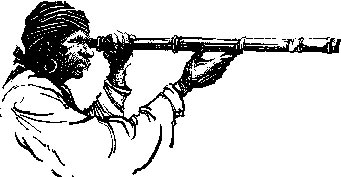



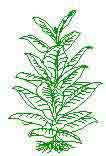 Now that we've gotten nearly all the 2005 crop out of the field and into the barn, attention will turn to getting that crop processed and off to market. Tobacco growers' hands will be full in the coming months, no doubt. That being said, we also need to begin thinking about diseases and how to go about getting a head start on managing them. The 2005 season was a rough one in terms of the drought and also the alarming incidence of black shank and other diseases across KY. We can't do anything about the weather, for the most part, but growers can take some steps now that will make a big difference on the level of disease in next year's crop.
Now that we've gotten nearly all the 2005 crop out of the field and into the barn, attention will turn to getting that crop processed and off to market. Tobacco growers' hands will be full in the coming months, no doubt. That being said, we also need to begin thinking about diseases and how to go about getting a head start on managing them. The 2005 season was a rough one in terms of the drought and also the alarming incidence of black shank and other diseases across KY. We can't do anything about the weather, for the most part, but growers can take some steps now that will make a big difference on the level of disease in next year's crop.
The first thing that comes to mind is SANITATION. Many diseases that we see in the float system and field survive between crops on equipment and plant residues. Transplant houses and outdoor beds should be cleaned and sanitized now to cut down overwintering populations of pathogens. Plant debris and trash should be buried or burned, and all trays should be cleaned carefully and sanitized as recommended (or destroyed). In the field, particularly where black shank was present, all crop debris needs to be turned in as quickly as possible after harvest. The black shank pathogen (as well as Rhizoctonia and Pythium) can survive quite well on tobacco stalks, and stalks left in the field will provide more inoculum for future outbreaks of disease. Plowing under crop residues now gives more time for soil microbes to break down plant matter and will have a greater impact on reducing pathogen survival over the winter than waiting until next spring.
It's also time to think about ROTATION. Simply put, there's no better tool for managing diseases like black shank than rotation to a non-host crop. Even though we are many months from planting, growers need to start the planning process and make decisions on field choice and potential rotation crops.
Please check the KY Blue Mold Warning System page for in the coming months for reports on our 2005 fungicide trials, as well as management tips and other news relating to tobacco diseases.
For the latest blue mold status and other tobacco disease information, check the KY Blue Mold Warning System online.
![]() http://www.uky.edu/Agriculture/kpn/kyblue/kyblue.htm
http://www.uky.edu/Agriculture/kpn/kyblue/kyblue.htm

For more information about tobacco pests, visit "Insect Management Recommendations".
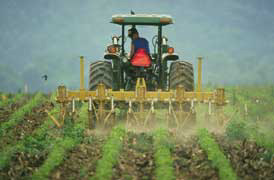
![]() Never mind the cool weather or the calendar date, soybean insect season is NOT over! I have received several calls and e-mails concerning defoliation of late planted beans. Some of these problems are obviously green cloverworm but in a few cases the culprit is not evident. So, what is going on?
Never mind the cool weather or the calendar date, soybean insect season is NOT over! I have received several calls and e-mails concerning defoliation of late planted beans. Some of these problems are obviously green cloverworm but in a few cases the culprit is not evident. So, what is going on?
 Green cloverworm
Green cloverworm populations are still a threat in some areas. Though full season / early maturing beans are not at risk, later planted / maturing beans are still green and attractive to this pest. The threat will decrease with time, but should not be completely ignored. Also, a few people have reported considerable defoliation in beans but no obvious insect pest. This is likely green cloverworm populations that have collapsed under the pressure of natural enemies (especially parasitoid wasps).
Green cloverworm
Green cloverworm populations are still a threat in some areas. Though full season / early maturing beans are not at risk, later planted / maturing beans are still green and attractive to this pest. The threat will decrease with time, but should not be completely ignored. Also, a few people have reported considerable defoliation in beans but no obvious insect pest. This is likely green cloverworm populations that have collapsed under the pressure of natural enemies (especially parasitoid wasps).
 Fall armyworm
The numbers of fall armyworm (FAW) moths caught in pheromone baited traps (see the pheromone trap results near the end of this and other issues of KPN) continue to increase and be greater than normal. Last weeks' news letter (http://www.uky.edu/Agriculture/kpn/kpn_05/pn050912.htm#annunu)
contained an article that addressed this situation. FAW will continue to be a threat on a wide variety of crops, until the first killing frost.
Fall armyworm
The numbers of fall armyworm (FAW) moths caught in pheromone baited traps (see the pheromone trap results near the end of this and other issues of KPN) continue to increase and be greater than normal. Last weeks' news letter (http://www.uky.edu/Agriculture/kpn/kpn_05/pn050912.htm#annunu)
contained an article that addressed this situation. FAW will continue to be a threat on a wide variety of crops, until the first killing frost.
Soybean aphid It was about his time last year (21 Sept. 04) that I began to get calls on large populations of soybean aphid in soybean in central KY. Central Tennessee also had a late population of soybean aphid in 2004. My guess is that it has been too hot and dry for this to happen in 2005, but I would certainly encourage you to check late planted / maturing beans (anything earlier than R6) for aphids. Insects have made a liar out of me more than once!
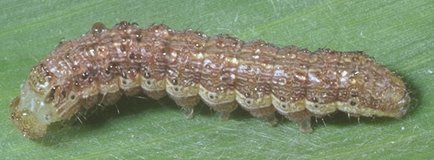 Corn earworm (aka soybean podworm)
I am still receiving reports of this insect damaging soybean fields. So far there has been little problem, but it is one of the more dangerous pest of late planted / maturing beans in KY. They are relatively easily controlled in soybeans, but most often go undetected until the damage is done. Insecticides will control the pests but will not put the yield back on the plant. You must get in to the field and look for damaged pods. Leaf feeding is often not a good indicator.
Corn earworm (aka soybean podworm)
I am still receiving reports of this insect damaging soybean fields. So far there has been little problem, but it is one of the more dangerous pest of late planted / maturing beans in KY. They are relatively easily controlled in soybeans, but most often go undetected until the damage is done. Insecticides will control the pests but will not put the yield back on the plant. You must get in to the field and look for damaged pods. Leaf feeding is often not a good indicator.
For more information about soybean pests, visit
"Insect Management Recommendations".


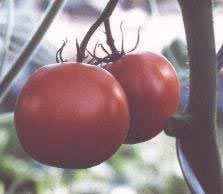 There have been many new insecticides that have cleared registration for certain vegetable crops. This increases the tools we have for managing insect pests in vegetables in Kentucky. However, if not for a few exceptions, these new insecticides are primarily from two chemical classes, the pyrethroids and the neonicotinoids. While the number of insecticides is increasing rapidly, them number of rotational options is only increasing slowly.
There have been many new insecticides that have cleared registration for certain vegetable crops. This increases the tools we have for managing insect pests in vegetables in Kentucky. However, if not for a few exceptions, these new insecticides are primarily from two chemical classes, the pyrethroids and the neonicotinoids. While the number of insecticides is increasing rapidly, them number of rotational options is only increasing slowly.
For example, with the neonicotinoids for tomatoes we have Admire (imidacloprid), Provado (imidacloprid), Platinum (thiamethoxam), Assail (acetamiprid), and Venom (dinotefuran). These are all Group 4A insecticides according to the Insecticide Resistance Action Committee, IRAC. Admire, Platinum, and Venom are approved only for soil application while Assail, Provado, and Venom are approved only for foliar application. Soil applications of these materials can provide long-residual activity against some insect pests. Only one or two applications of Admire, Platinum, and Venom to the soil are permitted, depending on the particular product, see specific labels for limitations. Foliar applications Assail, Provado, and Venom should not be used following a soil application with any of the Group 4A, neonicotinoid, insecticides. In crops where a soil application has not been used them foliar applications of Assail, Provado, and Venom are permitted. Where multiple foliar applications are used, growers must stay within the seasonal limits listed on the label and periodically rotate to insecticides with different modes of action (a different IRAC group number).
In terms of pyrethroids insecticides labeled for tomatoes, we have a large group that includes Asana XL, Baythroid, Capture, Danitol, Decis, Mustang Max, Pounce, Proaxis, and Warrior. In addition to these there are a large number of insecticides based on generic active ingredients that are similar Capture, Pounce, and Warrior. These are Group 3 insecticides and all share the same mode of action. Growers need to recognize which insecticides belong to similar groups and share the same mode of action. The IRAC insecticide groupings listed prominently on many insecticides labels will assist growers. While a few sequential applications can be made with pyrethroid insecticides, growers must alternate these with insecticides with alternative modes of action.

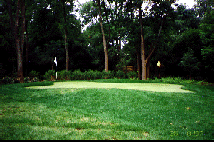
Fairly aggressive epidemics of gray leaf spot on perennial ryegrass have developed in a number of locations in Louisville, Lexington, and north. Continued warm weather has favored disease activity into the last week of September. However, forecasts for this week indicate the advent of more seasonable weather, with daytime highs in the mid- to upper 70's and lows in the mid 50's or cooler. This weather should slow disease activity.
Many swards where significant damage occurred will be overseeded in the coming weeks. Keep in mind that seedlings of perennial ryegrass are highly susceptible to the disease, and inoculum levels in damaged swards are high. After seeding, be prepared to monitor the weather and the swards themselves. If we experience a return to several days of warm, humid weather, it is possible that some swards will benefit from a fungicide application, to protect them from a sudden death. Damaging levels of gray leaf spot activity in October are not common in Kentucky, but it can and does occur from time to time.
Information on efficacy of fungicides for controlling gray leaf spot is available in the UK Extension
publication found at:
http://www.ca.uky.edu/agcollege/plantpathology/ext_files/PPFShtml/PPFS-OR-T-03%2804-05%29.pdf

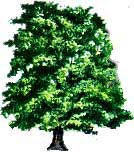
This is a good time of year for Christmas tree growers to assess their disease management program. Going into the fall, if trees have not withstood the stresses of drought and the ravages of diseases, they will not be suitable for sale for the holidays. In Kentucky, a wide range of conifer species are grown for Christmas tree production including Scots pine, white pine, white and blue spruces, Douglas-fir, and Canaan and Fraser firs.
Some root rot and canker diseases are common to all species of trees grown for Christmas tree production. Management of these diseases follows:
Scots pines and white pines are subject to several important needle blight, canker, and root rot diseases in the field. Cultural practices such as raking up fallen needles, maintaining plant vigor, watering during drought, improving plant spacing, controlling weeds, and selecting a planting site to avoid excess soil moisture aid in disease management. Pine diseases may include:
Spruce trees can develop a needle cast disease.
Douglas-fir is subject to two needle cast diseases. Reduce needle cast disease through proper tree spacing and weed control to improve air circulation.
Portions of this article were adapted from a report written by Ann Gould, Rutgers University Extension Plant Pathologist, and published in their March 17, 2005 Plant and Pest Advisory newsletter.
As of this writing, the following fungicides were labeled for use in Christmas trees (plantation, landscape, nursery, or seed bed): Azoxystrobin, chlorothalonil, copper hydroxide, copper salts of fatty and rosin acids, copper sulfate, etridiazole, ferbam, fludioxonil, flutolanil, fosetyl-Al, Gliocladium virens GL-21, mancozeb, Mancozeb + copper hydroxide (Junction), mancozeb + myclobutanil (Manhandle), mefenoxam, myclobutanil, phosphite, propamocarb hydrochloride, propiconazole, Streptomyces griseoviridis K61, thiophanate-methyl, thiophanate-methyl + chlorothalonil (ConSyst, Spectro, thiophanate-methyl + etridiazole (Banrot), thiophanate-methyl + flutolanil (SysStar), triadimefon, triflumizole, ziram. This list is prepared for educational uses; it may be incomplete and it does not imply any preference.


Recent samples in the Diagnostic Laboratory have included charcoal rot, Fusarium and Gibberella stalk rots on corn; charcoal rot, brown spot, Fusarium root/stem rot, Diaporthe pod/stem blight and Pythium root rot on soybean; and a potyvirus on tobacco.
On fruit and vegetable samples, we have observed sooty blotch/flyspeck, cedar-apple rust and thread blight on apple; potyvirus complex on pumpkin; and early blight and bacterial canker on tomato.
On ornamentals and turf, we have seen bacterial soft rot on iris; Rhizoctonia web blight on chrysanthemum and holly; Pestalotiopsis tip blight on arborvitae; Septoria leaf spot on dogwood; Pythium blight on bentgrass; summer patch and anthracnose on bluegrass; and brown patch and anthracnose on fescue.

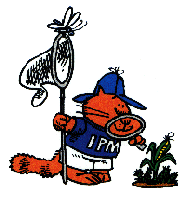
UKREC-Princeton, KY, September 9-16, 2005| Corn Earworm
| 40
| European Corn Borer
| 2
| Southwestern Corn Borer
| 5
| Fall Armyworm
| 87
| | |
UKREC-Princeton, KY, September 16-23, 2005| Corn Earworm
| 16
| European Corn Borer
| 0
| Southwestern Corn Borer
| 3
| Fall Armyworm
| 66
| | |
View Princeton trap counts for the entire 2005 season at - http://www.uky.edu/Ag/IPMPrinceton/Counts/2005trapsfp.htm
Fulton County trap counts are available at -http://ces.ca.uky.edu/fulton/anr/Insect%20Counts.htm
For information on trap counts in southern Illinois visit the Hines Report at - http://www.ipm.uiuc.edu/pubs/hines_report/comments.html The Hines Report is posted weekly by Ron Hines, Senior Research Specialist, at the University of Illinois Dixon Springs Agricultural Center.
NOTE: Trade names are used to simplify the information presented in this newsletter. No endorsement by the Cooperative Extension Service is intended, nor is criticism implied of similar products that are not named.
Lee Townsend
Extension Entomologist